| Core races | |||
| Allied races | |||
Template:Lang
  | ||||||||||
|
Template:Racebox |
||||||||||
  | ||||||||||
Prince Kael'Thas Sunstrider, Lord of Quel'Thalas
The blood elves, or sin'dorei ("Children of the Blood" in Thalassian), are a race composed of former high elves who renamed themselves in honor of their people that were killed during the siege of Quel'Thalas by the Scourge during the Third War. The blood elves of Azeroth have joined the Horde in the Burning Crusade expansion, seeking to reunite with Prince Kael'thas Sunstrider in Outland. They have since reclaimed their capital of Silvermoon City, situated in Eversong Woods.
Introduction and history
Ten thousand years ago, during the reign of the night elf Queen Azshara, there was an elite magic-using sect known as the Highborne, who dabbled in magics that many other elves considered heretical by drawing upon the power of the Well of Eternity. Fiercely loyal to the Queen, the Highborne opened a number of portals under her direction that brought forth the Burning Legion, triggering the War of the Ancients. Some time after the Great Sundering, most of the surviving Highborne were exiled from Kalimdor and settled on the Eastern Continent, founding the kingdom of Quel'Thalas. They became known as high elves. During this time, they created the Sunwell, and switched to a diurnal waking cycle. Their purple skin eventually faded to a pale peach color, like that of the humans and dwarves.
For the history of the high elves in the years between their exile and the Third War, see High elf.
During the Third War, Prince Arthas led his army of the Scourge against them, ravaging Quel'Thalas and corrupting the Sunwell. Most of what was left of Quel'thalas was burned down by the high elves, in an effort to give the scourge a psychological victory and leaving the few high elves left who were making their last stand on Sunstrider Isle. Despite their efforts, most of the high elven population were eradicated during this conflict. In remembrance of their fallen brethren, most of them renamed themselves the blood elves, or sin'dorei, and swore to avenge their fallen race.
Cut off from their source of power once again, the elves went into magic withdrawal. Desperate for aid following the Third War, the blood elves accepted help from the naga. This was seen as treachery by the Alliance and they were sentenced to death. Prince Kael'thas Sunstrider led his followers to freedom, to the extra dimensional wastes of Outland, the remnants of Draenor, and pledged allegiance to Illidan who promised to grant them a new source of magic by siphoning the chaotic energies of demons. Together with their allies the naga, Illidan led the blood elves to conquer Outland, gaining in the process the friendship of the nearly extinct Broken. The blood elves then followed Illidan to the Icecrown Glacier in an attempt to destroy the Lich King. However, they were defeated by Arthas, who wounded Illidan, forcing the blood elves and naga to retreat, allowing Arthas to ascend the glacier and merge with the Lich King.
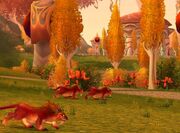
The blood elf starting area, Sunstrider Isle
But not all blood elves currently reside in Outland with Illidan: some have remained in Azeroth. Flushed with their newfound ability to siphon mana from creatures of the Twisting Nether, the blood elves have managed to retake their beloved land of Quel'Thalas. Silvermoon has been rebuilt and the resident blood elves there plot to return to Outland, where they can reunite with Kael'thas and achieve the golden destiny he promised them.
Unfortunately, the decisions of Kael'thas to continually accept the aid of the naga and willingness to use fel magic has caused blood elves to be shunned by the Alliance. Thus, the remaining blood elves on Azeroth looked to the Horde to help them reach Outland. Addiction to fel magics and the desperate search for a cure are things the orcs are very familiar with, and many older orcs who've experienced similar addictions feel a kinship with the blood elves. The trolls who have been the ancient enemy of all quel'dorei since antiquity accepted them warily.
The Forsaken have been working closely with the blood elves to purge the greater Plaguelands of Scourge presence since their induction. Lor'themar Theron was Sylvanas Windrunner's second in command during the Second Battle of Quel'Thalas, and many Forsaken were high elves culled from the same battle. The aid provided by the Forsaken has included reinforcements, a number of outposts in and around the reclaimed blood elf territories, and a teleportation device between the Undercity and Silvermoon.
Physical appearance
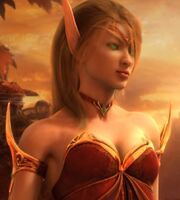
A CGI representation of a Blood Elf Priest
Blood elves between the Third War and World of Warcraft were physically identical to high elves, save that they dressed primarily in blacks and reds to remind themselves of their terrible losses. Many painted runes or mysterious tattoos on their faces, arms and shoulders for warding off demons or celebrating significant kills or simply to look intimidating — something high elves would never do. As well, they adopted hair styles that went against the norms of high elf society.Template:Cite
Currently blood elves flesh tones has turned ruddier or very pale, compared to their night elf and high elf cousins. A blood elf can appear like a high elf bearing odd red tattoos across her face and arms. However, her hair and skin are much paler than that of a high elf, and her eyes glint with a green light, and she wears blood-red robes.Template:Cite Their exposure to the light of day and the power of the Sunwell may have altered their skin's pigment.[citation needed] Blood elves also have a slim athletic body, long pointy ears, acute senses and keen sight in the darkness. Night elves have long, slanted ears while blood elves' ears are shorter and tend to point upwards. See High elf for a more complete description.
They feed on mana from mainly felTemplate:CiteTemplate:Cite, and recently arcaneTemplate:Cite, and divine[1] sources. The reliance on fel magic causes the eyes of blood elves to glow green with demonic fire. It is a slight evolution from their high elven cousins, and in time they may become as physically distant to high elves, as satyrs are to night elves Template:Cite (see Wretched). The eyes appear to be passed on genetically as blood elf children have been seen to possess them. This readily available source of energy also tends to give blood elves a ruddier or paler look compared to their quel'dorei brethren. Nevertheless when approaching Alliance towns blood elves would often disguise themselves as high elves to avoid harm. Template:Cite
It was once said that although blood elves show some physical differences compared to high elves, blood elves and high elves are exactly the same biological race[2]. Its use of the term "race" was likely an equivocation of the definition of the term "species," as race has more to do with cultural differences, and species has more to do with the biological. However, in Monster Guide, 2007, there is confirmation that the blood elven race is starting to evolve away from high elves due to use and consumption of fel magic. This is likely in reference to the wretched. Player blood elves absorb a variety of magic, including fel. In earlier Warcraft RPG books set during a period before WoW or TBC, they were considered separate races more by cultural differences rather than because of any physical differences.Template:CiteTemplate:Cite.
In The Frozen Throne blood elf eyes were white and pupilless in game and in the official artwork.
The sin'dorei live to be approximately 390-400 years old. How fast they reach maturity is under discussion but it is generally accepted that they grow as fast as humans do until their twenties at which point their growth decelerates and they age very slowly.
Culture
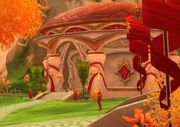
Blood elven architecture
Blood elves wear crimson-colored robes to suggest their fiery affiliation and the blood of the fallen elves in Quel'thalas. Many concentrate on studying arcane and fire magic, as opposed to the traditional frost and water spells of their lost high elf society.
Blood elf architecture involves pendulous creations of wondrous curves and columns, its designs natural, floral, flowing, animal. Their fountains seem to defy physical boundaries, creating or warping water in impossible ways. Blood elves have flags that feature a phoenix. In the Third War, Blood Mages had the ability to call phoenixes from the Elemental Plane of fire. These creatures appear to be deeply connected with the blood elves, possibly because they share a destructive nature, or perhaps due to their purely magical composition. This could allow the blood elves to have increased control over them. Since the phoenix dies and becomes reborn, it could be a symbol for the blood elves -- the blood elves metaphorically 'died' as high elves and were reborn as blood elves.
Blood elves speak Thalassian and Orcish. Blood elves learn the languages of their allies.Template:CiteTemplate:Cite
Magical addiction
Since the destruction of the Sunwell at the hands of Arthas and the Scourge, the blood elves have been forced to deal with the sudden relapse of their addiction to arcane energy. A constant curse since the original Well of Eternity was destroyed, the addiction has become more powerful than ever. Blood elves spend their waking days struggling with their weakness, seeking either to sate it by siphoning magical energy from their surroundings or to resist the urge to feed.
While the blood elves do not abstain from draining arcane power directly, they are careful to keep their addictions under control, keeping the power their new abilities offer while maintaining self-discipline. Those who lose control over their addiction change into "The Wretched," and invariably fall into insanity and corruption.
As Arcanist Helion (a starting zone quest NPC) says, "Control your thirst for magic...It is a thirst unending." [3]
Alignment
This article or section includes speculation, observations or opinions possibly supported by lore or by Blizzard officials. It should not be taken as representing official lore.
|
Tensions from the aftermath of the Second War have become burning hatreds. The high elves officially withdrew from the Alliance after the Second War under the belief that not enough troops were sent to protect Quel'thalas, and thus led to a needlessly engorged amount of slaughter and destruction. A few high elves remained under their own volition to continue serving the Alliance, but the loyalty of even these voluntary troops waned after the second sacking of Quel'Thalas by Arthas, to which the Alliance took no steps in intervening. Finally, with Lord Garithos's dismissive, blatantly racist treatment of high elven troops and attempt to execute many blood elves for accepting boats from naga, even more fell under the sway of Kael'thas' new vision for his people, and the high elves who remained loyal even after all of the Alliance's poor policies in dealing with the elven race still faced discrimination from the very people they served in Theramore and Stormwind.
As a result, blood elves are fierce jingoists, believing that the only people they can truly trust are their own. They are perceived as reckless and haughty, exhibiting none of the serenity or calm judgment of their ancestral peoples, and jumping at opportunity and quick solutions with little regard for the consequences. They believe power is not something to be earned -- it is to be taken. Power is something to be manipulated for yourself and the greater good of all blood elves. This reasoning also plays into how the blood elves successfully drained pure Light energy from the naaru to become Blood Knights, and paying no interest to the Paladin credos of benevolence or asceticism (Not that regular paladins can't be corrupt) .
The official The Burning Crusade webpage mentions blood elves having a "dark destiny"[4]. This likely refers to the fact that blood elves under Kael'thas had joined with the Burning Legion, under the demonic Illidan and the naga. This likely is not in reference to the majority of blood elves who were left on Azeroth that do not know about Kael'thas' decision. Indeed, many of those back on Azeroth chose to turn against Kael'thas when they learned of it.Template:Cite A large faction of blood elves previously under the direct command of Kael'thas defected, and are now known as the Scryers, and currently operate to fight against the prince.
Most blood elves are not insane or evil - they just choose to fight fire with fire. They were suffering for lack of the Sunwell; they all needed -- and still need -- to feed on arcane energies, even though most of them aren't spellcasters. The most powerful blood elf spellcasters are insane, as the magic they wield is corrupting.Template:Cite On the other hand, the Farstriders, using little magic, are considered to be the epitome of selfless dedication, and are called valiant, honorable and noble on the official site.[5]
Playable race
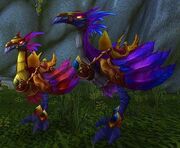
Two epic hawkstriders
The blood elves start in the Eversong Woods, the northern section of Quel'Thalas. Farther south is the Ghostlands, a level 10-20 zone. [6]
Their capital city is Silvermoon.
The racial mount for the blood elf is called the hawkstrider, although at first they were named 'cockatrices' as announced by Gamespot. [7]. Blood elf paladins (blood knights) have a charger-like horse that is black with bronze and red armor.[8]
The blood elf languages are Thalassian and Orcish, and they are able to pick the hunter, priest, warlock, rogue, mage and paladin classes.
Relationships
Blood elves have differing feelings toward orcs - some complain that they burned their forests in the Second War, whilst others feel they weren't the same orcs (psychologically). Darkspear trolls have neutral feelings toward blood elves, but some blood elves discriminate against them. It is unknown what they think of tauren. They are friendliest with the Forsaken.
Leadership in Quel'Thalas
Lor'themar Theron, Regent of Quel'Thalas: Leader of the blood elves on Azeroth in the Prince's absence.
Grand Magister Rommath: Leader of all blood elf Magi on Azeroth, and a fiercely loyal servant of Kael'thas.
Halduron Brightwing: Ranger-General of Silvermoon, the blood elves' military commander on Azeroth, leader of the Farstriders (organization of blood elven rangers).
Racial abilities
 [Mana Tap]
[Mana Tap]- Activate to reduce target's mana by (50 + Level) and charge you with arcane energy for 10 min. This effect stacks up to 3 times. 30 yd range - Instant - 30 sec cooldown.
 [Arcane Torrent]
[Arcane Torrent]- Activate to silence all enemies within 8 yards for 2 seconds. In addition, you gain 10 energy or (5 + Level) mana for each charge of Mana Tap currently affecting you.
- Arcane Affinity
- 10 point skill bonus to Enchanting (note, this also raises the cap by 10 at each level of enchanting).
- Magic Resistance
- Increase all Resistances by 5.
Blood elf priests receive two racial abilities - ![]() [Consume Magic] and
[Consume Magic] and ![]() [Touch of Weakness]:
[Touch of Weakness]:
- Consume Magic dispels one beneficial Magic effect from the caster and gives them 120 to 154 mana. (660 to 694 mana at level 70) - instant cast, two minutes cooldown.
- Touch of Weakness is a buff that the priest can cast upon him or herself. It lasts for ten minutes and has only one charge, and once cast, will cause shadow damage to the melee damage inflicter, and affects that target with a debuff that reduces their damage done by a constant amount. The amount of damage done and damage reduced increases with levels.
Reasons for racial abilities
The elves have long delved into the magical and arcane as evident by their cultural centerpiece, the Sunwell. Thus, they have developed a natural Arcane Affinity as a result of the well's magical presence, making the blood elves naturally skilled with arcane arts such as Enchanting. The elves' constant exposure to the Sunwell also gave them a natural defense against many kinds of magical manipulation, granting them a natural Magical Resistance. After the destruction of the Sunwell during the Third War, the remaining blood elves developed the skill of Mana Tapping to feed their magical addiction, allowing them to tap into the arcane energies of other beings. Arcane Torrent comes as a natural manipulation of these consumed energies and allows the elves to absorb and unleash the energies gathered.
Classes
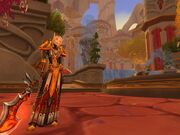
A female paladin (Blood Knight)
Blood elf characters can play as the following classes: [9]
Blood elves are the only Horde race able to play as Paladins. For balance, the draenei are the only Alliance race to be able to play as shaman. Blood elves are the only playable race who do not have the Warrior option. This was due to the limit on the number of classes a race is able to choose.
Blood elf lore classes
- Blood Mage
- Spell Breaker
Starting Attributes
| Base | Mage | Rogue | Warlock | Hunter | Paladin | Priest | |
| Strength | 17 | 17 | 18 | 17 | 17 | 19 | 17 |
| Agility | 22 | 22 | 25 | 22 | 25 | 22 | 22 |
| Stamina | 18 | 18 | 19 | 19 | 19 | 20 | 18 |
| Intellect | 24 | 27 | 24 | 26 | 24 | 24 | 26 |
| Spirit | 19 | 21 | 19 | 21 | 20 | 20 | 22 |
Trivia
- Blood elves are the more popular of the two new races released in The Burning Crusade, and currently the most popular Horde race. On servers that started after the release of The Burning Crusade, the Blood Elves are often the most popular or second-most popular race overal.
- It is interesting to note that the female blood elf dance is derived from the dance routine in the music video for Britney Spears' song "Toxic", which lyrics happen to be a very spot-on description of the magical addiction blood elves suffer.
- The blood elf female laugh is meant to reference the catchphrase of Doctor Blight, from the TV series Captain Planet and the Planeteers. Also, the image that displays next to the health bars of blood elf females in your party that are outside your visual range bears a distinct resemblance to the Doctor.
- The male blood elf dance is almost exactly identical to the dance that Napoleon does in the movie Napoleon Dynamite[10]
- Contrary to popular belief, blood elves still have a strong affinity with nature, especially the Farstrider rangers. Like the Quel'dorei before them, the sin'dorei have druids, but they are not the same as kaldorei or tauren druids; the blood elf variety of druids are closer to traditional "medieval" druids, working to conserve and maintain the natural environment of Quel'Thalas. While most cannot shape-shift, they share some of the same druid spells such as Speak with Plants. While most are not shape-shifters, there is at least one shape shifting druid (High Botanist Freywinn).
See also
- Rise of the Blood Elves, from the History of Warcraft
- History of the blood elves
- List of blood elves in Azeroth
- Blood elf units in Warcraft III
- Blood elf controversy
External links
| ||||||||||||||||||||||||
